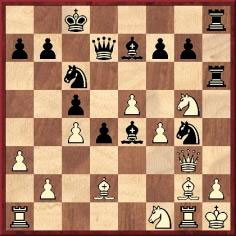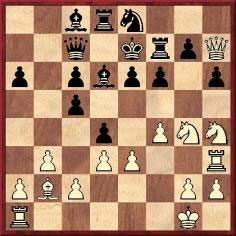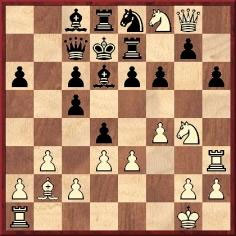Chess Explorations (6)
By Edward Winter
‘An ordinary version of the smothered mate’ was Steinitz’s
comment regarding our first game when he annotated it in his International
Chess Magazine, January 1885, pages 24-25. His opponent was R. Stein, the
occasion being a 22-board simultaneous exhibition in New York on 27 November
1884.

White to move
Steinitz announced mate in five moves by 16 Qe6+ Kb8 17 Nd7+ Kc8 18 Nxb6+ Kb8
19 Qc8+ Rxc8 20 Nd7 mate.
 W. Steinitz
W. Steinitz
One of the great beauties of chess is the way a theme may lend itself to countless
variants. In the next example, taken from the BCM of June 1920 (page
171), there is a pin on the white queen. The players’ names were not recorded.

Black to move
The game ended 1...Rxg2 2 Qxg2 Qg1+ 3 Rxg1 Nf2 mate.
Sometimes a little more preparatory work is required, as in this position from
the game F. Dus-Chotimirsky-Penin, St Petersburg (date uncertain):

Black to move
1...Nh3 2 Rf1 Rd2 3 Nxd2 Qg1+ 4 Rxg1 Nf2 mate.
Source: Deutsches Wochenschach, 28 August 1910, page 314.

White to move
This position arose in a game between S. Levitzky and M. Chigorin at a tournament
in Moscow on 1 October 1899. Faced with immediate mate on g2, Levitzky played
the neat, if forced, move 41 Qb2. The attempted swindle did not work, and the
game continued 41...Qd5 42 Bxf3 Qxd8, after which White resigned.
Source: Wiener Schachzeitung, November 1899, pages 182-184.

M. Chigorin
The game below, from page 36 of the January 1907 BCM, shows the white
king hemmed in by pieces only (no pawns):
O.C. Müller – H.V. Crane
London, 22 October 1906
Albin Counter-Gambit
1 d4 d5 2 c4 e5 3 dxe5 d4 4 a3 c5 5 f4 Nc6 6 Nf3 Bf5 7 g3 Be7 8 Bg2 h5 9 O-O
h4 10 Qe1 (Teichmann: ‘White’s game soon becomes altogether hopeless,
and the tragi-comic conclusion seems a just punishment for having missed the
right moment to resign.’) 10... hxg3 11 Qxg3 Rh6 12 Kh1 Rg6 13 Qe1 Qd7
14 Rg1 O-O-O 15 Nbd2 Nh6 16 Nf1 Rh8 17 Bd2 Ng4 18 e4
18...Bxe4 19 Ng5 Rgh6 20 Qg3
20...Rxh2+ 21 Nxh2 Rxh2+ 22 Qxh2 Nf2 mate.
When the king is not mated in the corner, the winner may need help from an
advanced pawn.

White to move
G.H. Mackenzie mated in five moves: 28 Qh6+ Ke8 29 Ng7+ Kf8 (If 29...Rxg7 then
30 Qh8+) 30 Ne6+ Ke8 31 Qf8+ Rxf8 32 Ng7 mate.
Source: Brooklyn Chess Chronicle, 15 September 1884, page 184.

G.H. Mackenzie
The smothering manoeuvre may merely be the preface to a different winning motif,
such as the so-called corridor mate.

White to move
This game was won by Edmond Gestesi in March 1911 at the Café de la
Régence, Paris, and play went as follows: 1 Bc5 Nd3+ 2 Kb1 Nxc5 3 Nf7+
Kg8 (3...Rxf7 4 Rxd8+ Rf8 was necessary.) 4 Nh6+ Kh8
5 Qg8+ Rxg8 6 Nf7+ Qxf7 7 Rxh7+ Kxh7 8 Rh1 mate.
Source: La Stratégie, May 1911, page 177.
Our final specimen is also spectacular. It comes from page 100 of 1 P-KB4
(A Guide to Bird’s Opening) by R.E. Robinson (Liverpool, 1950):
F.W. Viney – H.F. Gook
Match: General Post Office v Customs, 3 December 1926
Bird’s Opening
1 f4 e6 2 Nf3 d5 3 e3 c5 4 b3 Nc6 5 Bb5 Bd7 6 Bb2 Nf6 7 O-O a6 8 Bxc6 bxc6
9 d3 Bd6 10 Nbd2 Qc7 11 Ne5 O-O 12 Qf3 Rad8 13 Qg3 Ne8 14 Qh4 f6 15 Ng4 Be7
16 Rf3 Rf7 17 Rh3 h6 18 Qh5 Bc8 19 Qg6 Kf8 20 Nf3 d4 21 Qh7 Bd6 22 Nh4 Ke7
23 Ng6+ Kd7 24 Qg8 Re7 25 Nf8 mate.
Submit information
or suggestions on chess explorations
All articles by Edward
Winter
 Edward
Winter is the editor of Chess
Notes, which was founded in January 1982 as "a forum for aficionados
to discuss all matters relating to the Royal Pastime". Since then over
5,600 items have been published, and the series has resulted in four books by
Winter: Chess
Explorations (1996), Kings,
Commoners and Knaves (1999), A
Chess Omnibus (2003) and Chess
Facts and Fables (2006). He is also the author of a monograph
on Capablanca (1989).
Edward
Winter is the editor of Chess
Notes, which was founded in January 1982 as "a forum for aficionados
to discuss all matters relating to the Royal Pastime". Since then over
5,600 items have been published, and the series has resulted in four books by
Winter: Chess
Explorations (1996), Kings,
Commoners and Knaves (1999), A
Chess Omnibus (2003) and Chess
Facts and Fables (2006). He is also the author of a monograph
on Capablanca (1989).
Chess Notes is well known for its historical research, and anyone browsing
in its archives
will find a wealth of unknown games, accounts of historical mysteries, quotes
and quips, and other material of every kind imaginable. Correspondents from
around the world contribute items, and they include not only "ordinary
readers" but also some eminent historians – and, indeed, some eminent
masters. Chess Notes is located at the Chess
History Center. Signed copies of Edward Winter's publications are
currently available.


































 Edward
Winter is the editor of
Edward
Winter is the editor of 




